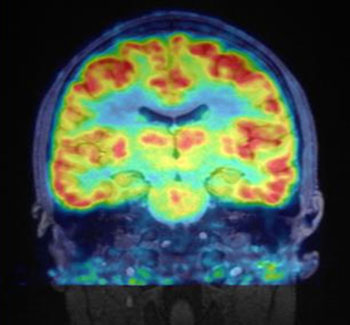New PET Tracer Images Epigenetics of the Human Brain
By MedImaging International staff writers
Posted on 25 Aug 2016
A novel positron emission tomography (PET) radiotracer can help reveal epigenetic activity within the human brain, claims a new study.Posted on 25 Aug 2016
Developed by researchers at the Martinos Center for Biomedical Imaging (NMR; Charlestown, MA, USA), part of Massachusetts General Hospital (MGH; Boston, USA), Martinostat is patterned after histone deacetylase (HDAC) inhibitors in order to tightly bind to HDAC molecules in the brain. PET scans of the brains of eight healthy human volunteers who received Martinostat revealed characteristic patterns of uptake--reflecting HDAC expression levels--that were consistent among all participants.

Image: Human brain MR-PET image using Martinostat (Photo courtesy of NMR).
The results revealed that HDAC expression was almost twice as high in gray matter as in white matter; and within gray matter structures, uptake was highest in the hippocampus and amygdala, and lowest in the putamen and cerebellum. Experiments with brain tissues from humans and baboons confirmed Martinostat's binding to HDAC, and studies with neural progenitor stem cells revealed specific genes regulated by this group of HDACs, many of which are known to be important in brain health and disease. The study was published on August 10, 2016, in Science Translational Medicine.
“HDAC dysregulation has been implicated in a growing number of brain diseases, so being able to study HDAC regulation both in the normal brain and through the progression of disease should help us better understand disease processes,” said senior author associate professor of radiology Jacob Hooker, PhD. “We've now started studies of patients with several neurologic or psychiatric disorders, and I believe Martinostat will help us understand the different ways these conditions are manifested and provide new insights into potential therapies.”
“The ability to image the epigenetic machinery in the human brain can provide a way to begin understanding interactions between genes and the environment,” added Dr. Hooker. “This could allow us to investigate questions such as why some people genetically predisposed to a disease are protected from it? Why events during early life and adolescence have such a lasting impact on brain health? Is it possible to ‘reset’ gene expression in the human brain?”
Epigenetics is the study of heritable changes in gene expression that does not involve changes to the underlying DNA sequence--i.e. a change in phenotype without a change in genotype--which in turn affects how cells read the genes. Epigenetic change is a regular and natural occurrence, but can also be influenced by several factors including age, the environment/lifestyle, and disease state. Epigenetic modifications can manifest as commonly as the manner in which cells terminally differentiate to end up as skin cells, liver cells, brain cells, etc. Epigenetic change can also have more damaging effects that can result in diseases like cancer.
Related Links:
Martinos Center for Biomedical Imaging
Massachusetts General Hospital













.jpg)
